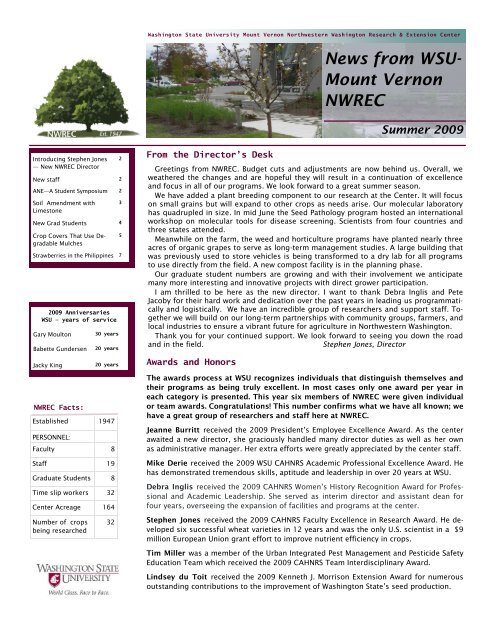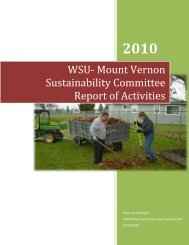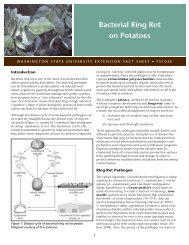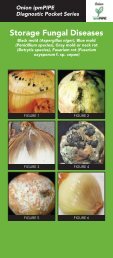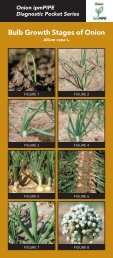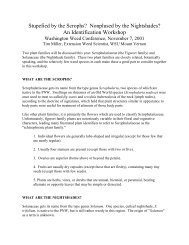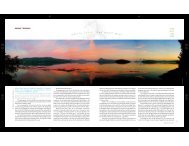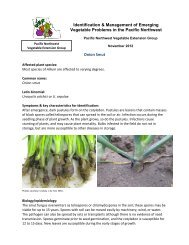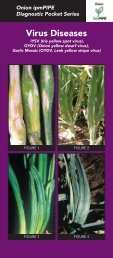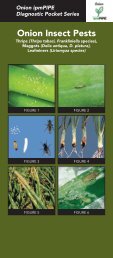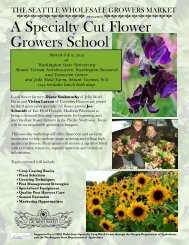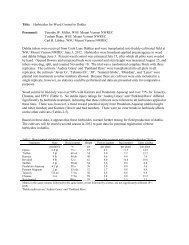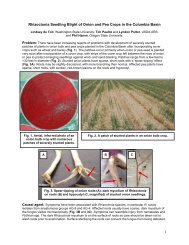Summer 2009 - WSU Mount Vernon Research and Extension Unit
Summer 2009 - WSU Mount Vernon Research and Extension Unit
Summer 2009 - WSU Mount Vernon Research and Extension Unit
- No tags were found...
Create successful ePaper yourself
Turn your PDF publications into a flip-book with our unique Google optimized e-Paper software.
Washington State University <strong>Mount</strong> <strong>Vernon</strong> Northwestern Washington <strong>Research</strong> & <strong>Extension</strong> CenterNews from <strong>WSU</strong>-<strong>Mount</strong> <strong>Vernon</strong>NWREC<strong>Summer</strong> <strong>2009</strong>Introducing Stephen Jones— New NWREC DirectorNew staff 2ANE—A Student Symposium 2Soil Amendment withLimestoneNew Grad Students 4Crop Covers That Use DegradableMulchesStrawberries in the Philippines 7<strong>2009</strong> Anniversaries<strong>WSU</strong> — years of serviceGary MoultonBabette GundersenJacky KingNWREC Facts:Established 1947PERSONNEL:Faculty 8Staff 19Graduate Students 8Time slip workers 32Center Acreage 164Number of cropsbeing researched30 years20 years20 years32235From the Director’s DeskGreetings from NWREC. Budget cuts <strong>and</strong> adjustments are now behind us. Overall, weweathered the changes <strong>and</strong> are hopeful they will result in a continuation of excellence<strong>and</strong> focus in all of our programs. We look forward to a great summer season.We have added a plant breeding component to our research at the Center. It will focuson small grains but will exp<strong>and</strong> to other crops as needs arise. Our molecular laboratoryhas quadrupled in size. In mid June the Seed Pathology program hosted an internationalworkshop on molecular tools for disease screening. Scientists from four countries <strong>and</strong>three states attended.Meanwhile on the farm, the weed <strong>and</strong> horticulture programs have planted nearly threeacres of organic grapes to serve as long-term management studies. A large building thatwas previously used to store vehicles is being transformed to a dry lab for all programsto use directly from the field. A new compost facility is in the planning phase.Our graduate student numbers are growing <strong>and</strong> with their involvement we anticipatemany more interesting <strong>and</strong> innovative projects with direct grower participation.I am thrilled to be here as the new director. I want to thank Debra Inglis <strong>and</strong> PeteJacoby for their hard work <strong>and</strong> dedication over the past years in leading us programmatically<strong>and</strong> logistically. We have an incredible group of researchers <strong>and</strong> support staff. Togetherwe will build on our long-term partnerships with community groups, farmers, <strong>and</strong>local industries to ensure a vibrant future for agriculture in Northwestern Washington.Thank you for your continued support. We look forward to seeing you down the road<strong>and</strong> in the field.Stephen Jones, DirectorAwards <strong>and</strong> HonorsThe awards process at <strong>WSU</strong> recognizes individuals that distinguish themselves <strong>and</strong>their programs as being truly excellent. In most cases only one award per year ineach category is presented. This year six members of NWREC were given individualor team awards. Congratulations! This number confirms what we have all known; wehave a great group of researchers <strong>and</strong> staff here at NWREC.Jeanne Burritt received the <strong>2009</strong> President’s Employee Excellence Award. As the centerawaited a new director, she graciously h<strong>and</strong>led many director duties as well as her ownas administrative manager. Her extra efforts were greatly appreciated by the center staff.Mike Derie received the <strong>2009</strong> <strong>WSU</strong> CAHNRS Academic Professional Excellence Award. Hehas demonstrated tremendous skills, aptitude <strong>and</strong> leadership in over 20 years at <strong>WSU</strong>.Debra Inglis received the <strong>2009</strong> CAHNRS Women’s History Recognition Award for Professional<strong>and</strong> Academic Leadership. She served as interim director <strong>and</strong> assistant dean forfour years, overseeing the expansion of facilities <strong>and</strong> programs at the center.Stephen Jones received the <strong>2009</strong> CAHNRS Faculty Excellence in <strong>Research</strong> Award. He developedsix successful wheat varieties in 12 years <strong>and</strong> was the only U.S. scientist in a $9million European Union grant effort to improve nutrient efficiency in crops.Tim Miller was a member of the Urban Integrated Pest Management <strong>and</strong> Pesticide SafetyEducation Team which received the <strong>2009</strong> CAHNRS Team Interdisciplinary Award.Lindsey du Toit received the <strong>2009</strong> Kenneth J. Morrison <strong>Extension</strong> Award for numerousoutst<strong>and</strong>ing contributions to the improvement of Washington State’s seed production.
P a g e 2N e w s f r o m W S U - M o u n t V e r n o n N W R E CNew DirectorDr. Stephen JonesNew Staff<strong>WSU</strong>-<strong>Mount</strong> <strong>Vernon</strong> NWREC welcomes new director, Stephen S. Jones. He assumed the director’srole on May 15, <strong>2009</strong>, bringing with him many plant breeding projects including lowinputwheat, perennial wheat, organic wheat <strong>and</strong> improving nitrogen use efficiency in cropplants. Dr. Jones looks forward to exp<strong>and</strong>ing his research in areas relevant to the agriculturaldiversity in the Skagit Valley <strong>and</strong> surrounding areas <strong>and</strong> provide help to people from homegardeners to large scale operations. He was a molecular cytogeneticist for the USDA’s Agricultural<strong>Research</strong> Service at the <strong>WSU</strong> campus <strong>and</strong> joined the <strong>WSU</strong> faculty in 1995. His researchhas been featured in The New York Times, Gourmet Magazine, The Wall Street Journal, Newsweek,Audubon, <strong>and</strong> National Geographic. He has written the ―wheat‖ entry for World BookEncyclopedia, <strong>and</strong> co-authored the entry for ―sustainable agriculture‖ with Dr. Carol Miles, whoalso works at the NWREC. Dr. Jones received his bachelor’s degree from California State University,Chico; he also has a master’s in agronomy <strong>and</strong> a doctorate in genetics from Universityof California, Davis.Jamie Anderson has been employed as a Fiscal Technician in the NWREC Administrative Office since September,2008. She is a welcome addition <strong>and</strong> has previous fiscal experience working for Skagit Pediatrics <strong>and</strong>other businesses in <strong>Mount</strong> <strong>Vernon</strong>. Jamie is a long time <strong>Mount</strong> <strong>Vernon</strong> resident. Her familiarity with the area isa great asset <strong>and</strong> is appreciated by visitors to NWREC who require directions or ask for information about theSkagit Valley. We are fortunate that Jamie has joined our staff; she is a quick study, professional, <strong>and</strong> a pleasureto work with.Ashley Bentley joined the General Administration department as the Office Assistant in June 2008 afterworking as a temporary employee in the following departments: General Administration, Vegetable Seed Pathology,<strong>and</strong> Weed Science. Her knowledge of these programs is a great benefit to her position in the frontoffice <strong>and</strong> her expertise in administrative operations has been welcomed. As well as being a new staff member,she is also relative newcomer to the state of Washington having moved here from Arkansas with her husb<strong>and</strong><strong>and</strong> dog in July 2006.Matthew Reichlin started in the new Farmer 2 position in March, 2008. Matthew is a graduate of <strong>Mount</strong><strong>Vernon</strong> High School, <strong>and</strong> has previously worked at Pleasant Valley Farms, Delta Breeze Farms <strong>and</strong> StaffansonHarvesting in the Skagit Valley. He has experience operating <strong>and</strong> maintaining farm machinery, <strong>and</strong> doing awide variety of farming <strong>and</strong> food production tasks. NWREC is very pleased to have him join the GA staff.Agriculture <strong>and</strong> Northwest Ecosystems:A graduate student symposiumBringing community <strong>and</strong> research togetherNovember 10, <strong>2009</strong>Agriculture is a fundamental component of northwestern Washington’s community <strong>and</strong> economy, yet there aregrowing concerns regarding agricultural sustainability <strong>and</strong> the effects of certain farming practices on wildlifehabitat, water quality <strong>and</strong> soil health. Underst<strong>and</strong>ing the dynamics of our agricultural environment, in the contextof conservation <strong>and</strong> community needs, is essential to developing sustainable food systems for the future.The purpose of this symposium is to display the wide range of graduate student research projects relatedto agriculture <strong>and</strong> natural resource conservation, now on-going in northwestern Washington. Graduatestudents <strong>and</strong> their faculty advisors from multiple disciplines <strong>and</strong> universities will engage with community participantsin conversations about agricultural sustainability <strong>and</strong> resource management strategies. Local organizations<strong>and</strong> individuals will learn about regionally based graduate research now underway. All participantswill have the opportunity to contribute ideas for new research topics <strong>and</strong> helps foster collaborations amongWashington’s universities, students, <strong>and</strong> agricultural <strong>and</strong> natural resource organizations in the future.This event will be held at <strong>WSU</strong>-NWREC in <strong>Mount</strong> <strong>Vernon</strong>, WA. More information <strong>and</strong> a detailed schedule will beposted on our website in July. There will also be a graduate student reception at the Olson Heritage Farmhousefollowing the symposium. If you wish further information please contact Jessica Gigot atjgigot@wsu.edu .
N e w s f r o m W S U - M o u n t V e r n o n N W R E CP a g e 3Soil Amendment with Limestone for Managing Fusarium Wilt in Spinach Seed Crops in the PNWSpinach seed crops in western Washington <strong>and</strong> Oregon annually produce 30-50% of theU.S. <strong>and</strong> ≤ 25% of the world supply of spinach seed. Few areas of the world have the climaticconditions of the coastal PNW required to produce spinach seed - long summerdays to trigger flowering, dry summers to minimize pathogens infecting the developingseed, <strong>and</strong> mild temperatures for uniform flowering. However, Fusarium wilt (caused bythe soilborne fungus Fusarium oxysporum f. sp. spinaciae) has become the primaryfactor limiting spinach seed production in the PNW.Cultivars with partial resistance are available, but many carry little or no resistance. Thepathogen can survive >10-20 years in soils. Producers originally managed Fusarium wiltby growing seed crops in fields not previously planted to spinach. Subsequent depletionof virgin ground led to Fusarium wilt becoming the main factor limiting production ofspinach seed. Losses to Fusarium wilt now necessitate rotations of 6-10 years for spinachlines with partial resistance, <strong>and</strong> 12-15 years for susceptible lines. Fields that meet these constraints <strong>and</strong> the requiredpollen isolation distances for seed crops are increasingly difficult to find. In contrast, ~15,000 acres of spinach seedcrops are grown in Denmark annually on 4-5 year rotations.The alkaline <strong>and</strong> calcareous soils in Denmark appear to suppress spinach Fusarium wilt. Since 2006, the Vegetable SeedPathology program has investigated limestone applications to suppress spinach Fusarium wilt which could enable seedgrowers to reduce rotation intervals from 6-15 years to 5-8 years. An annual trial in growers’ fields evaluated rates oflimestone amendment on spinach lines ranging from susceptible to partially resistant to Fusarium wilt.Spinach Fusarium wilt trial <strong>2009</strong>—<strong>and</strong> Avi AlcalaResultsBy July (mid-season) each year, limestone applied at ≥ 1 ton/acre had significantlysuppressed Fusarium wilt. Plant biomass was greatest in plots with limestone.The best disease suppression <strong>and</strong> highest yields were in plots with ~2tons/acre. The effects were most significant for susceptible spinach lines, withlimestone reducing wilt up to 45% <strong>and</strong> increasing yields as much as 300%. Forpartially resistant lines, seed yield was highest at ~2-3 tons limestone/acre, <strong>and</strong>decreased at higher <strong>and</strong> lower rates. Soil pH, <strong>and</strong> soil <strong>and</strong> plant calcium (Ca)concentrations increased with increasing rate of limestone amendment. Rates>1 ton/acre reduced available zinc (Zn) <strong>and</strong> manganese (Mn) in soil <strong>and</strong> plants.Ca is important in host resistance, while Zn <strong>and</strong> Mn may promote aggressivenessof some Fusarium wilt fungi. Mn <strong>and</strong> Zn are also essential for plants, sodecreased yields at higher rates of limestone on partially resistant spinach linesmay be associated with inadequate Zn <strong>and</strong>/or Mn for seed crops at the higher soil pH. The amount of F. oxysporum detectedin the soil at harvest in plots with a partially resistant line was about 50% that of plots with a susceptible line, i.e.,rotation intervals necessary between seed crops to avoid Fusarium wilt may need to be longer following crops with susceptiblelines than following crops with more resistant lines.A PhD student, Emily Gatch, is using these results to assess mechanisms of Fusarium wilt suppressionto optimize <strong>and</strong> integrate this with other cultural practices. The objectives of Emily’sproject are to: 1) investigate soil properties that affect host-pathogen interactions; 2) develop asoil bioassay as a risk assessment tool for growers to select fields for seed crops; <strong>and</strong>, 3) assesslevels of Fusarium wilt suppression induced with annual applications of limestone <strong>and</strong> other culturalpractices to lower the carrying capacity of PNW soils for this pathogen. Using the new CoreMolecular Lab at the NWREC, the Vegetable Seed Pathology program is working with Dr. Pat Okubara,USDA ARS pathologist in Pullman, to develop a molecular tool for detecting the spinachFusarium wilt pathogen in soils in order to help growers assess the risk of Fusarium wilt.ConclusionsThis research has demonstrated clearly the potential for limestone applications to render naturallyconducive soils of the PNW more suppressive to spinach Fusarium wilt. As a result, manyspinach seed growers in the PNW <strong>and</strong> some in Holl<strong>and</strong> have increased the rate of limestoneamendment they use to grow spinach seed crops on acid soils, apparently with positive results.The research is expected to increase the capacity for spinach seed production in the US. Pleasecontact Lindsey du Toit (dutoit@wsu.edu or 360-848-6140) with questions or suggestions.Different rates of limestoneapplied to plotsEmily Gatch (in front)<strong>and</strong> Barb HolmesAcknowledgementsThe Puget Sound Seed Growers’ Association, WA State Commission for Pesticide Registration, Alfred Christianson Endowment,Robert MacDonald Graduate Student Fund, Western SARE, <strong>and</strong> USDA Western Region IPM provided financial supportfor this project. The project received in-kind support from the Western WA Small Seed Advisory Committee <strong>and</strong> seed companies,<strong>and</strong> excellent technical support from Mike Derie, Louise Brissey, Barbara Holmes, Ron Dralle, Matt Reichlin, KerriBrooks, Ashley Bentley, Amy Christianson, Coen de Jong, Gabby Freier, <strong>and</strong> Katie Reed.
P a g e 4N e w s f r o m W S U - M o u n t V e r n o n N W R E CNew Graduate StudentsJessica Gigot is a new PhD student in the Small Fruit Horticultureprogram. Jessica received her B.A. in biology <strong>and</strong> anthropologyfrom Middlebury College in Vermont in 2001. Followinggraduation she returned home to Washington to pursue her interestin agriculture. After working on various farm <strong>and</strong> garden projectsin the northwest she completed an internship, funded by theKellogg Foundation, at S&S Homestead on Lopez Isl<strong>and</strong>, a <strong>WSU</strong>-Center for Sustaining Agriculture <strong>and</strong> Natural Resources demonstrationfarm. In 2006, she completed her M.S. degree (with Dr.Debra Inglis) in plant pathology from <strong>WSU</strong> <strong>and</strong> her thesis work wasfocused on the survival <strong>and</strong> transmission of Phytophthora infestanson volunteer potatoes. Jessica is interested in plant healthmanagement <strong>and</strong> defining soil quality parameters in both annual<strong>and</strong> perennial cropping systems. Her doctoral research project isrelated to sustainable management of Phytophthora rubi <strong>and</strong>nematode communities in raspberry systems.Emily Gatch joined the Vegetable Seed Pathology program infall semester of 2008, <strong>and</strong> is working on a PhD program in plantpathology. Emily grew up on a farm in eastern Iowa, <strong>and</strong> had anearly introduction to the world of seed through summer jobs detasslingcorn <strong>and</strong> working for a prairie seed company. Emily obtaineda BS in biology from Harvard University, followed by an MSL. to R. Avi Alcala, Emily Gatch, Jessica Gigotin plant pathology at Iowa State University. Emily’s MS thesis project examined the interaction of Bt corn hybrids<strong>and</strong> stalk rot, caused by a complex of fungal pathogens that includes several species of Fusarium. After finishingher degree in 2001, Emily worked for three years as a research associate at the West Tennessee <strong>Research</strong> <strong>and</strong> EducationCenter, reporting to both the horticulturalist <strong>and</strong> plant pathologist in the vegetable crops division. Emily latermoved to New Mexico where she held a position as greenhouse <strong>and</strong> pathology coordinator at the research farm ofSeeds of Change, an organic vegetable, herb, <strong>and</strong> flower seed company. In her efforts to assess <strong>and</strong> manage seedbornedisease challenges for the company, Emily became aware of the research program of Lindsey du Toit, <strong>and</strong>joined Lindsey’s lab at the <strong>WSU</strong> <strong>Mount</strong> <strong>Vernon</strong> NWREC in August 2008, investigating management strategies for controlof Fusarium wilt in spinach seed crops.Jennifer Niem, an MS student in Vegetable Pathology program, has joined Debbie Inglis <strong>and</strong> Babette Gundersenin the Vegetable Pathology program. Ms. Niem obtained a BS degree in Agriculture with a plant pathology majorfrom the University of The Philippines at Los Baños in 1999. From 1999-2001 she worked at the Volcani Center inIsrael on a CDR-USAID project preventing post-harvest decays in subtropical fruits. Following, she held a positionwith UPLB, researching diseases of banana. She attended classes in the spring in Pullman <strong>and</strong> arrived at our researchcenter in May. Her thesis project will be on the effects of flooding on survival of soilborne pathogens of potato,<strong>and</strong> is part of The Nature Conservancy’s Farming-for-Wildlife project.Ana Vida Alcala ('Avi') joined the Vegetable Seed Pathology program in January<strong>2009</strong>, <strong>and</strong> will be doing her PhD project on seed treatments for organic vegetableproduction. Avi took classes in Pullman in the spring <strong>and</strong> will attend in thefall semesters of <strong>2009</strong>, but will be at the NWREC this summer <strong>and</strong> full-time nextspring to work on her PhD research project. Avi completed her BS degree in agriculturefollowed by an MS degree in Plant Pathology, both from the Universityof the Philippines at Los Baños. Avi worked on the control of a postharvest diseasecaused by Colletotricum gloeosporioides on mango (Mangifera indica) forher MS thesis. Afterwards, Avi worked as a researcher on biological control ofsoilborne diseases of vegetables in the tropics, <strong>and</strong> management of postharvestdiseases of paddy rice at the Philippine Rice <strong>Research</strong> Institute.(Continued on next page)
N e w s f r o m W S U - M o u n t V e r n o n N W R E CP a g e 5New Graduate Students … continuedLucas Patzek joined the Plant Breeding <strong>and</strong> Pathology programs as a PhD student in the fall of 2008. Growingup he spent nearly equal portions of his life in Texas <strong>and</strong> California. From an early age his parents nurtured inhim a love of nature <strong>and</strong> exposed him to the magical worlds of biology, physics, chemistry, <strong>and</strong> mathematics. Hebegan his undergraduate studies at the University of California at Santa Cruz in Physics, <strong>and</strong> took coursework inthat direction for three years. Ultimately he decided on a life sciences degree, <strong>and</strong> in 2005 received a BS in Molecular,Cellular <strong>and</strong> Developmental Biology. After graduation he went to work at the Harvard Medical Schoolwhere he researched Alzheimer's disease. Wanting to return to plant science (<strong>and</strong> Berkeley) he then studied theecological <strong>and</strong> social impacts of oil palm plantations, <strong>and</strong> held the managing director position at the Green CenturyInstitute, an educational non-profit operating in green urbanism. While working in the non-profit sector, Lucashelped organize numerous public debates, teach-ins, the 7th International Ecocity Conference, <strong>and</strong> a greenurbanism design competition. His current research at NWREC addresses the design of low-input agricultural systems,especially from the st<strong>and</strong>-point of reduced nutrient <strong>and</strong> fungicide inputs, <strong>and</strong> the improved integration ofsuch systems with urban centers. His planned research spans the fields of pathology, genetics <strong>and</strong> sociology.Karen Hills joined the Plant Breeding program in <strong>2009</strong> as a PhD student. Sheearned a BS in Rural Sociology at Cornell University in 2000 <strong>and</strong> a MS in Plant <strong>and</strong>Soil Science at the University of Vermont in 2007 (thesis title: Disease Suppression<strong>and</strong> Soil Quality Indicators after Organic Amendment to Two Soils with DifferingManagement Histories.) Since 2007, she has been employed by University of Vermont<strong>Extension</strong> in the agronomy <strong>and</strong> nutrient management program. In this position,Karen has been involved with farmer nutrient management education for dairy<strong>and</strong> vegetable farmers, including the creation of an extension publication (DiggingIn: A Nutrient Management Curriculum for Farmers) <strong>and</strong> the modification of existingnutrient management tools for use with diversified vegetable farms. She hasbeen a collaborator on two SARE-funded projects investigating oilseed crops <strong>and</strong>their by–products as alternative crops for Vermont farmers (Seedmeal as anAmendment for High Value Crops; Oilseeds in New Engl<strong>and</strong>: A Farmer to FarmerExchange) <strong>and</strong> is currently conducting a study of nitrogen release rates fromamendments commonly used by organic vegetable producers in New Engl<strong>and</strong>. Karen’s interests include productionissues faced by diversified <strong>and</strong> sustainable farmers, including soil fertility, crop disease management, <strong>and</strong>minimizing the environmental impacts of agriculture.Undergraduate student internshipsLindsey du Toit <strong>and</strong> Lori Carris (<strong>WSU</strong> Mycologist in Pullman) received $2,000 each from <strong>WSU</strong> Associate Dean, KimKidwell, for a ―Translational Internship‖ for <strong>WSU</strong> freshman, Katie Reed, to create an opportunity for Katie to gaindirect experience working in research programs in Pullman <strong>and</strong> at NWREC while an undergraduate student. Katiecompleted a 1-day "Job Shadow" in Lindsey's program in winter 2007-08, <strong>and</strong> then expressed interest in studyingplant pathology at <strong>WSU</strong>. Katie is working on a molecular spinach project for Lindsey <strong>and</strong> Pat Okubara (USDA ARSpathologist in Pullman) together with Lacey Hulbert, another former "Job Shadow" high school student inLindsey's program who is completing a BS degree at <strong>WSU</strong>.Rick Sakuma of the Sakuma Brothers Farms worked as a volunteer in the vegetable <strong>and</strong> fruit horticulture programsthis past April <strong>and</strong> May. One of the reasons that he chose to volunteer was to further his knowledge ofhorticulture <strong>and</strong> to work with Gary Moulton in the enology program. Rick hopes in the future to be involved inthe wine <strong>and</strong> grape industry.Students graduating <strong>and</strong> finding jobsFormer MS student in Lindsey du Toit's vegetable seed pathology program, Jaime Cummings, took a position insoybean pathology with Monsanto Corp. in St. Louis, MO.MS student, Deron Beck, University of Idaho, completed his thesis on 'Management of Botrytis neck rot of onion<strong>and</strong> graduated in 2008. Lindsey du Toit served on Deron's MS thesis committee.
P a g e 6N e w s f r o m W S U - M o u n t V e r n o n N W R E C<strong>WSU</strong> <strong>Mount</strong> <strong>Vernon</strong> NWREC Scientists lead USDA Specialty Crop Planning Grant Project:Planning for Specialty Crop Covers that Use Degradable Mulchestomato high tunnel experiment using traditional black plastic mulch (July 2008)Drs. Debra Inglis <strong>and</strong> Carol Miles are the lead scientists on a USDA Specialty Crop Planning Grant entitled ProjectPlanning for Specialty Crop Covers that Use Degradable Mulches (Proposal Number: 2008-04831, $98,181).The team consists of 10 inter-disciplinary/multi-university members from University of Tennessee, Texas A&M,<strong>and</strong> Western Washington University. At <strong>WSU</strong>, team members include Drs. Karen Leonas (Apparel, Merch<strong>and</strong>ize,Design <strong>and</strong> Textiles), Tom Walters (Horticulture <strong>and</strong> L<strong>and</strong>scape Architecture), <strong>and</strong> Héctor Sáez (CSANR).The grant project: (i) assists with the adaptation <strong>and</strong> economic feasibility of high tunnels for the Pacific Northwest(PNW) (cool marine climate), Mid-South (hot, dry climate) <strong>and</strong> Southeast (warm, humid climate); (ii) seeks togain a better underst<strong>and</strong>ing of biodegradable mulch materials used to replace polyethylene plastic mulch, <strong>and</strong>(iii) to generate a better underst<strong>and</strong>ing of how biobiodegradable mulches may impact soilborne microorganisms<strong>and</strong> plant health.The team met last year at River Point, WI forproject planning <strong>and</strong> to attend the University ofWisconsin’s High Tunnel workshop. The meetingwas also attended by invited national leaders incrop covers <strong>and</strong> biodegradable materials. Stakeholdersfrom Washington (Curt Beus of <strong>WSU</strong> <strong>Extension</strong>Clallam County, Andrew Corbin of <strong>WSU</strong><strong>Extension</strong> Snohomish County, Tom Thornton ofCloud <strong>Mount</strong>ain Farm <strong>and</strong> Ben Craft of Alm HillGardens), Tennessee <strong>and</strong> Texas attended to provideproject feedback. A Key Informant Survey inNovember targeted selected growers <strong>and</strong> industrymembers in the northwest, south-central <strong>and</strong>southeast regions of the U.S. New information<strong>and</strong> perspectives about crop covers integratedwith biodegradable mulch materials is availableon NWREC’s website http://vegetables.wsu.edu/plasticulture.html. A primary outcome from thisplanning grant was the preparation <strong>and</strong> submissionof a $2 M SCRI SREP proposal in April <strong>2009</strong>.If funded, the project will take place in the threestates over the next 3 years. The authors gratefullyacknowledge CSREES for the award(# 51180-0488)tomatoes in high tunnel at last harvest,October 17, 2008; outside planting waseliminated by late blight <strong>and</strong> frost a month earlier
N e w s f r o m W S U - M o u n t V e r n o n N W R E C P a g e 7HighlightsDebra Inglis co-organized, with Carol Miles, for30 participants <strong>and</strong> scientific experts fromthroughout the U.S., a symposium held at Universityof Wisconsin River Falls, October 31-November1, on ―Using Degradable Materials for ProtectiveCrop Covers.‖Lindsey du Toit started as an Associate Editorfor the journal Phytopathology in January <strong>2009</strong>(<strong>2009</strong>-2011 term) <strong>and</strong> Agronomy Journal (Aug.2008-Jul. 2011 term), <strong>and</strong> in February she finisheda 3 year term as section editor for Plant DiseaseManagement Reports.Tim Miller received the 2008 Weed Warrioraward from the Washington Weed Association atthe annual Washington Weed Conference in Yakima.Kevin Murphy, Scot Hulbert, <strong>and</strong> Stephen Jonesreceived $600,000 in federal grants for organichops research.Lindsey du Toit <strong>and</strong> Mike Derie procured fundingfrom <strong>WSU</strong> ($50,000 with assistance from DeanPete Jacoby) <strong>and</strong> private donors ($8,000 fromSchafer Ag Services, Pop Vriend, <strong>and</strong> Gowan Seeds),<strong>and</strong> purchase equipment to set up the new CoreMolecular Lab at the <strong>WSU</strong> <strong>Mount</strong> <strong>Vernon</strong> NWREC.This lab has enabled molecular research to be completedby graduate students, faculty, <strong>and</strong> staff atthe NWREC, including real-time PCR analyses. Theconcept of this molecular lab was initiated byDebra Inglis while she served as Interim Director ofthe NWREC. Thank you Debbie!In May <strong>and</strong> June <strong>2009</strong> Tim Miller gave weedmanagement workshops in Puyallup, <strong>Mount</strong> Rainer,Port Angeles, Bellevue, Olympia, Mossyrock<strong>and</strong> George. He covered everything from cropplants to bulbs, to Christmas trees to turf grass.ECOLOGICALLY-BASED PARTICIPATORY IPM FOR SOUTHEAST ASIAStrawberry IPM Utilizing Native Predatory Mites for Biological Control ofSpider Mites in La Trinidad, Province of Benguet PhilippinesIn La Trinidad, strawberries not only representa high cash-value crop but the communityitself is defined by the industry, ―StrawberryCapitol of the Philippines.‖ Until the mid-1990’sthe La Trinidad strawberry industry foresaw noproblem with unrestricted pesticide use. By thelate 1990’s pesticide resistance had exacerbatedefforts to control spider mites <strong>and</strong> theindustry was in jeopardy of collapse.The final year of the USAID IPM CRSP fundedproject headed by Drs. Lynell Tanigoshi <strong>and</strong> Beverly Gerdemanfrom NWREC, has resulted in establishing the first native predatorymite mass production facility in the Philippines. This yearover 33,000 Neoseiulus longispinosus were released on 11 farmerstrawberry plots covering over 1 hectare in size. Weekly sampling<strong>and</strong> meetings with farmer-cooperators has changed theirattitude regarding use of predatory mites. To promote projectsustainability a successful publicity campaign was launched toincrease consumer awareness of beneficial mites <strong>and</strong> resultantreduction in pesticide usage <strong>and</strong> in developing a niche high-endmarket for those farmers using beneficial mites.Through the project’s funding, a h<strong>and</strong> tractor was presentedto the strawberry farmer association, OBSPA, to promote properplanting techniques<strong>and</strong> healthy strawberryplants to aid inresisting pests. As aresult, the communityis becoming unitedwith the help of WashingtonState University,USAID, <strong>and</strong> GovernorNestor Fongwanof Benguet province.Debra Inglis is serving as Senior Editor of the journalPlant Disease.On the Littau raspberry harvester: l. to r.Mike Particka (driving), Briana Moulton,Mindy Moulton, <strong>and</strong> Patrick Elhardt(quality inspection) July <strong>2009</strong>Tom Walters <strong>and</strong> IngaZ a s a d a r e c e i v e d$24,566 from the <strong>WSU</strong>Bio-Ag program for theproject ―Identification ofRoot Disease-CausingOrganisms <strong>and</strong> TheirManagement in WashingtonRaspberries‖.Jessica Gigot receiveda WSARE graduate studentgrant in sustainableagriculture ($17,626) for her project,―Sustainable root rot<strong>and</strong> soil management inraspberry‖. She also received the Eldred L. Jenne <strong>Research</strong>Scholarship for the <strong>2009</strong>/2010 school year from the Dept. ofHorticulture <strong>and</strong> the Elsie J. <strong>and</strong> Robert Aycock Travel Award toattend the <strong>2009</strong> National Plant Pathology meeting in Portl<strong>and</strong>.On April 8, <strong>2009</strong>, a reception was held at NWRECfor <strong>WSU</strong>’s new director of the Viticulture <strong>and</strong> EnologyProgram, Thomas Henick-Kling. 12 local wineries<strong>and</strong> vintners brought samples of their wines <strong>and</strong> over70 local business <strong>and</strong> community members attendedthe reception. Henick-Kling toured all of Washington’swine regions, noting that there is good opportunityfor growth in this industry for the state.Carol Miles served as host for three Borlaug Fellowsfrom Africa who were completing three monthinternships at <strong>WSU</strong> on organic agriculture. The individualsspent a week at the <strong>WSU</strong> <strong>Mount</strong> <strong>Vernon</strong>NWREC in October 2008, including time with each ofthe Vegetable Horticulture, Vegetable Pathology, <strong>and</strong>Vegetable Seed Pathology programs.The spring <strong>2009</strong> newsletter for the Seattle chapterof the Association of Women in Science (AWIS) includesan article ―Nurturing Agriculture in WesternWashington‖ which feature the research programs ofDrs. Debbie Inglis, Lindsey du Toit <strong>and</strong> Carol Miles.link: http://www.seattleawis.org/news.htm
Washington State University <strong>Mount</strong> <strong>Vernon</strong>Northwestern Washington <strong>Research</strong> & <strong>Extension</strong> Center16650 State Route 536<strong>Mount</strong> <strong>Vernon</strong>, WA 98273Phone: 360-848-6153Fax: 360-848-6159E-mail: ashleyb@wsu.eduVisit our website:www.mountvernon.wsu.eduThe mission of Washington State University’s Northwestern Washington R&E Center near <strong>Mount</strong> <strong>Vernon</strong> is toserve the agricultural, horticultural, <strong>and</strong> natural resource science interests of the state through research <strong>and</strong>extension activities that are enhanced by the unique conditions of northwestern Washington: its mild, marineclimate, rich alluvial soils, diverse small <strong>and</strong> mid-sized farming enterprises, <strong>and</strong> unique rural-urban interface.


